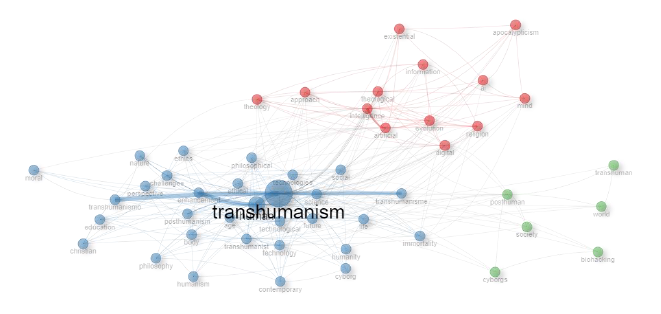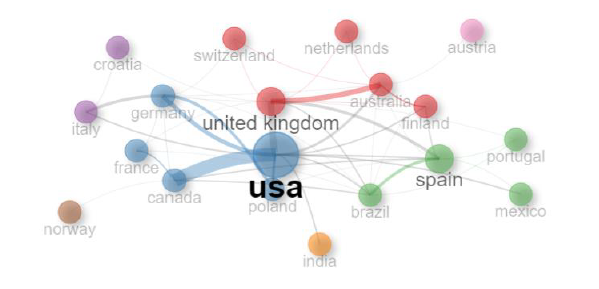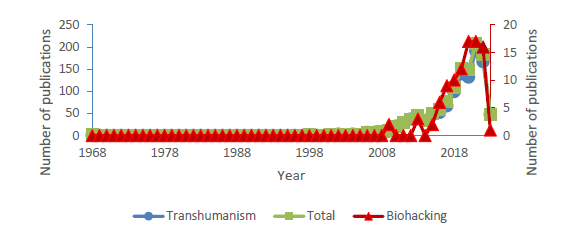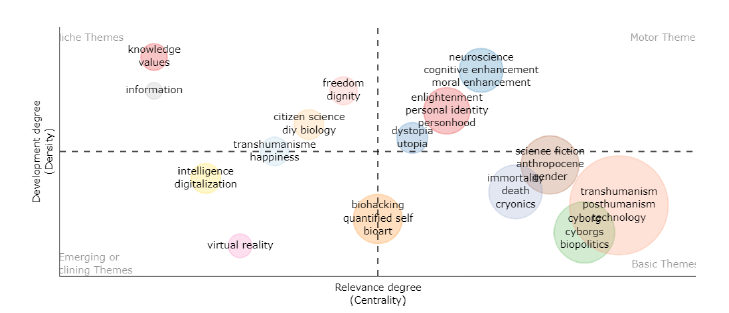Introduction
Transhumanism seeks to improve the human body and mind by applying technology (Cozza et al. 2022). This movement encompasses diverse perspectives, ranging from those who view human existence as paramount and reject the notion of escaping nature and the human body itself to those who see technology to surpass the limitations of biology (Boss, 2022). From the latter perspective, a sub-movement espoused primarily by amateur biologists has gained notoriety, challenging the traditional dominance of academia and industry (Schmidt, 2010). This movement, referred to as biohacking, involves individuals seeking to enhance their physical and cognitive capabilities through various means, including technological implants, lifestyle changes, and the employment of emerging genetic modification technologies, such as Clustered Regularly Interspaced Short Palindromic Repeats (CRISPR) (Kyslan, 2019; Le Dévédec & Collin, 2018; Peterson et al., 2022; Prada et al., 2019; Rifai, 2022).
The level of scholarly communication regarding human enhancement varies across disciplines and research areas. In the fields of bioethics and philosophy, there has been a long discussion and debate regarding the ethical implications of these practices. Studies in these fields have explored various perspectives and arguments related to morality, risks, and potential benefits of human enhancement (Birch, 2008; Roduit et al., 2015; Rosoff, 2011). However, other authors have noted the need for more empirical data and research to advance this debate (Gauttier, 2019). In the field of social sciences, there is a growing interest from sociological, anthropological, and cultural perspectives to understand the ideologies and subcultures associated with movements such as biohacking (Gauttier, 2019; Lima, 2023; Rozumko, 2023). In addition, the need to study governance, regulation, and to guide responsible research and innovation in the context of human enhancement has also been noted, with the aim of understanding the risks, challenges, and possible policy responses to these practices (Gorgoni, 2018; Prada et al., 2019). It should be noted that the level of scholarly communication on biohacking and human enhancement may vary across regions and countries. For example, some studies have highlighted the biohacking scene in Sweden and its connection to transhumanist agendas (Cozza et al., 2022). Furthermore, the availability of national instruments and ethical guidelines for research and breeding may vary across countries (Isa & Shuri, 2017). Overall, although there is a growing body of literature on biohacking and human enhancement, the level of scholarly communication varies across disciplines and research areas.
The transhumanist imaginary introduces several challenges in scholarly communication. One is the need to redefine what it means to be human in the context of technological improvements. Transhumanism blurs the line between humans and machines, raising questions about the nature of human identity and its implications for education and communication (Bugajska, 2022). In addition, transhumanism challenges traditional educational models (Castillo, 2023). Biohacking, viewed as a sub-movement of transhumanism, further complicates the challenges of scholarly communication. Biohacking practices raise questions about the role of informed consent, potential risks and benefits of self-modification, and ethical considerations surrounding the use of technology to enhance human capabilities (Noorulain Hyder et al., 2017).
The knowledge and understanding of what has been researched on transhumanism and biohacking is of inescapable relevance in the orientation of communication and education in this field of study. The scientific literature accumulated to date provides a fundamental basis for addressing rigor and the challenges emerging from this intersection between humanity and technology. By analyzing the various perspectives, approaches, and debates present in these academic studies, a holistic and critical view of the ethical, social, and cultural implications associated with technological advancement in the transhumanist context can be obtained. Thus, in this study, through a bibliometric analysis, we intend to approach emerging discourses, that is, those that present some degree of discursive innovation (Conde, 2019), around the social phenomenon of biohacking.
1. Methods
1.1 Database
In this study, the Scopus database was used to fulfill the research objectives. Scopus offers two search methods: a basic search and an advanced search, in which complex and long search queries can be performed to meet the objective with high validity. Scopus allows searching using terms in titles, abstracts, journal names, author names, or affiliations.
1.2 Search strategy and data collection
For this study, a bibliographic search was performed using field titles, keywords, and abstracts. The words "transhumanis*" and "biohack*" were used as the search terms. In Scopus, an asterisk is used as the search wildcard. In this way, the total number of 1231 articles were obtained, as well as separate sets and the intersection between both terms.
The documents retrieved from the search query on transhumanis* were referred to as "literature related to transhumanism.” This literature was found using the search string TITLE-ABS-KEY (transhumanis*), obtaining 1147 results. The documents retrieved from the search query using the keyword biohack* were referred to as "biohacking related literature.” This literature was obtained using the search string TITLE-ABS-KEY (biohack*), which returned 95 results.
In parallel, the groups of results obtained in both searches were reviewed, identifying common publications between both datasets with 11 articles.
1.3 Validation
The search queries were validated by reviewing the first 50 articles obtained. This was done to ensure that they fit the realm of transhumanism and biohacking. This approach was adopted to eliminate false-positive results by excluding studies that focused on other topics. Documents were not eliminated from the initial database.
1.4 Bibliometric indicators
The retrieved bibliographic data were exported from Scopus to the CSV format. The exported data included the annual growth in publications, types of documents, languages, countries, authors, institutions, journals, citations, and funding agencies. Subsequently, these data were exported and loaded into the R package of Bibliometrix software (Aria & Cuccurullo, 2017), converting them into a bibliographic data framework to calculate the different measures presented in this article and build graphical visualizations.
The analyzed data frame contains the necessary metadata for the total number of documents, total number of journals, total number of authors, citations, and total number of keywords used. With these data, it is possible to calculate the number of articles per author and the annual growth rate of the productivity analyzed.
In addition, academic productivity was evaluated in a geographical framework by analyzing academic productivity in different countries. The most productive authors were identified by measuring the number of publications and citations received. Likewise, the most relevant sources for the field of study were the number of publications on the subject contained in each journal. On the other hand, the most recurrent keywords in the publications were analyzed.
Finally, the degree of development and relevance of the topics addressed in the publications were assessed using a thematic map of keyword co-occurrence (Aria & Cuccurullo, 2017). Specifically, thematic analysis uses keyword groupings from authors and their interconnections to organize themes. These themes are characterized by properties such as density and centrality, where centrality is the degree of correlation between different themes and density is a measure of cohesion between nodes. The degrees of density and centrality are calculated directly by the Bibliometrix software and determine whether certain topics are well developed and whether they are important.
By plotting the density and centrality on a two-dimensional map, it is possible to classify the themes into quadrants: (1) upper right quadrant (high centrality and density): motor themes; (2) lower right quadrant: basic themes (high centrality, low density); (3) lower left quadrant: emerging or disappearing themes (low density and centrality); and (4) upper left quadrant: highly specialized or niche themes (low centrality and high density).
This study provides an overview of the evolution of academic productivity and insight into trends and patterns in the field of study.
2. Results
2.1 Volume, types, and growth of publications
The search query found 1147 papers in transhumanist literature and 95 papers in biohacking-related literature. There was an intersection between the two topics in 11 papers (Figure 1). The retrieved documents were of various types (data available at https://figshare.com/s/58c15b7f79b452b42dc5). Research articles constituted 63.5% (n = 728) of the literature related to transhumanism and 57.9% (n = 55) of the literature related to biohacking. There was a similar percentage of book chapters (n = 182; 15.9%) in transhumanism-related literature compared to biohacking-related literature (n = 14; 14.7%). Annual growth in publications was low but showed a steep increase after 2017. Figure 1 shows the growth of publications on transhumanism and biohacking on the two axes for ease of comparison.
2.2 Research topics
The mapping of the most frequent terms in the titles of papers in the literature related to transhumanism and biohacking yielded 50 nodes distributed in three clusters, representing three main research topics (Figure 2).

Figure 2 Visualization map of the co-occurrence network of terms in the document title field in literature related to transhumanism and biohacking. Map created with Bibliometrix.
The first group (red) includes 13 terms and focuses on the following topics in alphabetical order: ai, apocalypse, approach, artificial, digital, evolution, existential, information, intelligence, mind, religion, theological, theology. These terms can be grouped into the concepts of Artificial Intelligence (AI) and Technology, Cognitive Evolution, and Existential and Theological Concepts.
The second group (blue) includes 31 terms and focuses on the following topics in alphabetical order: age, body, challenges, Christian, contemporary, cyborg, education, improvement, ethical, ethics, future, human, humanism, humanity, immortality, life, moral, nature, perspective, philosophical, philosophy, posthumanism, science, social, technological, technologies, technologies, technology, transhumanism, transhumanism, transhumanism, transhumanism, transhumanist. These terms can be grouped into the concepts of human conditions and ethics, technological advances, religious and philosophical perspectives, and future and contemporary concepts.
The third cluster (green) includes six nodes and focuses on the following topics in alphabetical order: biohacking, cyborgs, posthumans, society, transhumans, and the world. These terms can be grouped under Transhumanism and Posthuman Concepts, and Social and Global Aspects.
2.3 Main keywords
An analysis of the keywords used by authors in the literature related to transhumanism indicated that posthumanism (122 occurrences), technology (85 occurrences), and artificial intelligence (71 occurrences) were the most frequent terms. The literature related to biohacking included citizen science (eight occurrences), diy biology (seven occurrences), and bioart and biopolitics (five occurrences) as the most frequent keywords (Table 1, visual map available at https://figshare.com/s/c1bbaaec2a195eb26cb9).
Table 1 List of the top 10 keywords used in the literature related to transhumanism and biohacking.
| Transhumanism | Biohacking | ||
|---|---|---|---|
| Keyword | Occurrences | Keyword | Occurrences |
| posthumanism | 122 | citizen science | 8 |
| technology | 85 | diy biology | 7 |
| artificial intelligence | 71 | bioart | 5 |
| human enhancement | 69 | biopolitics | 5 |
| enhancement | 61 | artificial intelligence | 4 |
| ethics | 45 | cyborg | 4 |
| posthuman | 37 | quantified self | 4 |
| cyborg | 33 | synthetic biology | 4 |
| immortality | 32 | regulation | 3 |
| human nature | 31 | biohackers | 2 |
2.4 Main countries, institutions, and international collaboration networks
The list of countries active in publishing papers related to transhumanism and biohacking is dominated by European countries. However, the USA led 259 (22.6%) papers in literature related to transhumanism and 58 (61.1%) papers in literature related to biohacking (Table available at https://figshare.com/s/bfa9c1ba52119535aa1d).
The U.S. also had the highest percentage of papers with international researchers, followed by the U.K. and Australia. Mapping of research collaboration in the literature related to transhumanism and biohacking in the 20 most active countries yielded seven major clusters, with the US and UK located in the center of the map (Figure 3). The United States and the United Kingdom shared similar research interests with most of the countries on the map, as both were in the center of the map. The thickness of the connection line (strength of the link) is proportional to the extent of research collaboration between connected countries. The size of each country node represents the percentage of papers published by international researchers. A larger node size indicates greater international research collaboration. A similar color indicates nearby research interest.

Figure 3 Visualization map of international collaborative research networks among the 20 countries most active in literature related to transhumanism and biohacking. The map was created using Bibliometrix.
The list of top institutions/organizations active in transhumanism-related literature is dominated by European and North American institutions, with the University of Helsinki in first place with 28 (2.44%) papers. In the biohacking literature, the list of the top ten most active institutions/organizations was also dominated by European and North American academic institutions. Baylor College of Medicine ranked first, with 12 (12.63%) papers (data available at https://figshare.com/s/06e4f49f2af9dd96b6fc).
2.5 Sources and active authors
For literature related to transhumanism, Zygon: Journal of Religion and Science was the leading source, with 22 (4.3%) papers. In the list of active journals, four sources belonged to the field of theology or religion, whereas five were from the fields of ethics and philosophy (Table 6). In terms of biohacking-related literature, nine of the ten most productive sources had two articles each. However, papers published in New Media and Society received the highest number of citations, with 182 citations. Among the most active journals, sources are varied and span the fields of health, engineering, and human-computer interaction (data available at https://dx.doi.org/10.6084/m9.figshare.24076365).
Researchers from Europe and North America have dominated both lists. The most active authors of the literature on transhumanism and biohacking were from the USA. In total, 1464 author names were involved in the publication of literature related to transhumanism and biohacking, with an average of 1.2 authors per paper. Seven hundred and seventy-seven (63.11%) had only one author (data available at https://figshare.com/s/23483ce2ed634c1196b4).
2.6 Motor topics
From the analysis, the motor themes, that is, those of the greatest development and relevance, are related to cognitive evolution. Concepts such as neuroscience, cognitive enhancement, moral enhancement, enlightenment, personal identity, personhood, dystopia, and utopia were grouped together.
The second quadrant refers to basic topics. These topics are not very developed in the research but are of great relevance. Clusters in this quadrant are characterized by low density and high levels of centrality. In this quadrant, we found topics related to science fiction, the Anthropocene and gender, immortality, death and cryonics, transhumanism, posthumanism and technology, and cyborgs and biopolitics.
The third quadrant shows emerging or declining themes. Here, we find topics related to intelligence and digitalization: virtual reality, biohacking related to bioart, and quantified self. The clusters in this quadrant are formed by less important and underdeveloped topics in the research, and this occurs at two points in the life of a topic: when it emerges or declines.
The fourth quadrant includes niche topics, that is, those that are highly developed, but of little relevance to research. As a result of the analysis, we observed themes related to happiness, such as values and knowledge, information, freedom and dignity, citizen science and DIY biology, and transhumanism (Figure 4).
2.7 Intersection
In our analysis, we found 11 publications at the intersection of the literature related to transhumanism and biohacking (Table 2). The articles analyzed in this body of literature address several common themes. These themes can be grouped into three thematic subsets: ethical considerations of human enhancement, biohacking, transhumanism, and society, and redefining the human body and identity through technology. The oldest article in this subset dates to 2017 (Doerksen, 2017), and the most recent corresponds to 2022 (Cozza et al., 2022). Within the set of 11 articles, 5 of them do not present citations, while one (Yetisen, 2018) concentrated 64% of the citations (38 total citations).
Table 2 Topics covered in articles at the intersection of biohacking and transhumanism.
| Theme | Main theme | Citation | Total Citations |
|---|---|---|---|
| Ethical considerations on human enhancement | Ethics of human enhancement and transhumanist technology. | (Yetisen, 2018) | 38 |
| Risk management in human enhancement technologies | (Gaspar et al., 2019) | 5 | |
| Ethical issues in biohacking and genetic improvement. | (Doerksen, 2017) | 5 | |
| Biohacking, transformation, and ethical limits | (Lima, 2023) | 4 | |
| Ethics and critical reflection in human enhancement | (Mercer & Trothen, 2021) | 4 | |
| Biological enhancement and ethical training | (Brickley, 2019) | 3 | |
| Biohacking, transhumanism and society | Biohacking in transhumanism: Social implications. | (Cozza et al., 2022) | 0 |
| Gene editing, automation, and ethical complexity | (Pisarski, 2021) | 0 | |
| Autonomy, automation, and technological impact | (Zabala Leal, 2021) | 0 | |
| Technological progress and human society | (Colado García, 2020) | 0 | |
| Redefining the body and identity through technology | Body intervention, transhumanism, and identity. | (Bour, 2019) | 0 |
3. Discussion and conclusions
This study was primarily undertaken to critically examine perspectives, approaches, and debates within the academic literature about implications of technological advancements within the transhumanist context. A special focus was placed on biohacking, given its emerging relevance in the discourse surrounding the accessibility of cutting-edge technologies like recombinant DNA.
Our analysis revealed a pronounced exponential growth in scientific interest surrounding transhumanism and biohacking, particularly marked from the year 2015 onwards. This surge is closely tied to seminal publications on CRISPR-Cas9 technology (e.g., Cong et al., 2013; Jinek et al., 2012; Mali et al., 2013), which have significantly influenced research on human enhancement and popularized the concept of biohacking. The dissemination of this technology appears to be a pivotal factor contributing to the increased volume of publications in this domain.
The scientometric analysis further illuminated an imbalance in the volume of literature between transhumanism and biohacking, with the latter having fewer publications at its peak. Despite this, the confluence of topics within the identified thematic clusters-ranging from technological advancements and human cognition to ethical considerations and the social implications of transhumanism-highlights a multidisciplinary approach to the discourse.
Notably, the cluster analyses, keywords and related literature revealed a notable absence of discussion on regulatory and legislative aspects. This gap highlights the need for more focused research on the governance of biohacking activities, ensuring safety and ethical integrity in the application of these emerging technologies from the normative that regulates their practices.
Our findings also point to the crucial role of public perception and acceptance of new technologies. The literature suggests that informed individuals are more likely to endorse the application of such technologies (Nayga et al., 2006), indicating the importance of accurate knowledge dissemination. This aspect is particularly relevant in the context of biohacking, which challenges traditional academic research paradigms by democratizing research to include amateur biologists and enthusiasts.
In addition to the pronounced exponential growth in scientific interest and the thematic clusters identified, our analysis shed light on key 'motor themes' that drive the discourse in transhumanism and biohacking. Among the motor themes, the concept of 'Cognitive Evolution' emerged as a prominent thread, encapsulating the pursuit of enhancing human cognitive and moral capacities through technological means. This concept refers to the continuous and transformative process of improvement and evolution of human cognition, ethics, and understanding of the self and society (Heyes, 2020; Lotem et al., 2017; Miller et al., 2020; Triki et al., 2022). This concept involves the exploration of neuroscience to enhance cognitive abilities, including intellectual and moral aspects, and ethical considerations surrounding these advances (Spink & Cole, 2007).
The discourse around Cognitive Evolution is enriched by discussions on personal identity, personhood, and the philosophical dichotomies of dystopia and utopia, painting a complex picture of the potential futures envisioned within transhumanist thought.
Another significant motor theme revolves around the ethical dimensions of biohacking and genetic modification. This includes vigorous debates on the moral implications of human enhancement, the boundaries of self-experimentation, and the societal impacts of widely accessible enhancement technologies. These discussions are crucial in navigating the ethical landscape of transhumanism, where the potential for profound changes to human nature and society looms large.
Again, the driving themes point to a gap on the importance of public engagement and policy development in the context of emerging technologies. The need for informed public discourse, evidence-based policy development, and ethical guidelines stands out as essential for the responsible development and application of transhumanist innovations and biohacking and is a gap to be filled in the promotion of research in this area.
These motor themes emphasize the need for a holistic approach that encompasses technological, ethical, and social considerations to fully understand and navigate the implications of transhumanist practices and ideologies.
The intersection of transhumanism and biohacking literature, as indicated by the analysis of 11 publications, underscores a multifaceted discourse that encompasses ethical, societal, and identity-related considerations inherent to human enhancement and technological integration.
The distribution of citations, with a significant concentration in a single publication, suggests the existence of pivotal works that have significantly influenced the discourse within this intersection. The absence of citations in half of the articles may point to emerging lines of inquiry or underexplored areas within the field, highlighting opportunities for further research and discussion.
In conclusion, the intersection of transhumanism and biohacking in academic literature encapsulates a critical examination of the profound implications of human enhancement technologies. It navigates through the ethical quandaries, societal impacts, and identity transformations engendered by the confluence of biology and technology, underscoring the need for continued scholarly attention to the multifaceted challenges and opportunities posed by this interdisciplinary domain.
While our analysis was comprehensive, it was limited to Scopus-indexed journals, potentially overlooking valuable insights from gray literature and non-indexed sources. This limitation underscores the need for more inclusive research methodologies in future studies.
Future research should aim to bridge the gaps identified, particularly by expanding the scope to include gray literature and non-English sources to provide a more global perspective. Additionally, the disparity in the volume of literature between biohacking and transhumanism calls for more focused research in these areas, developing studies on the regulatory aspects necessary for the ethical development of transhumanist practices, specifically biohacking.
In conclusion, our bibliometric analysis has not only mapped the current landscape of transhumanism and biohacking, but also highlighted the dynamic interplay between technology, ethics, and society. By framing our findings within the discourse of cognitive evolution, we contribute to a deeper understanding of possible changes in human cognition, ethics, and identity in the face of rapid technological advances, where regulation seems to lag behind advances in technology itself. This study paves the way for crucial new research to address the ethical, social, and practical challenges posed by biohacking and transhumanism, identifying the need for studies on regulation in these areas.
Author contributions
Conceptualization, F.G.P.; data curation, F.G.P.; formal analysis, F.G.P.; investigation, F.G.P.; methodology, F.G.P.; resourses; F.G.P.; software, F.G.P.; supervision, F.G.P.; validation, F.G.P.; visualization, F.G.P.; writing-original draft, F.G.P.; writing-review and editing, F.G.P.

















